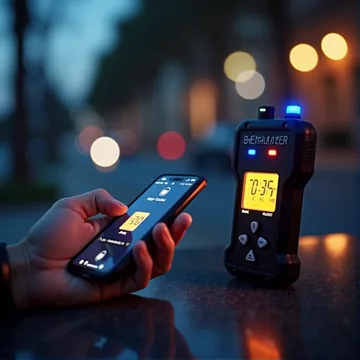Virtual vs Police Breathalyzer – Which Is Reliable?
Discover how virtual breathalyzer apps compare with police-grade devices. Learn what’s legally reliable, what’s only educational, and when a BAC calculator helps.

Why compare a virtual breathalyzer with a police device?
The market offers both virtual BAC calculators as apps and websites, and professional breathalyzers used by law enforcement. Both address the same phenomenon—blood alcohol concentration—but differ in technology, accuracy, and purpose. Understanding these differences is crucial to avoid a false sense of certainty.
Key differences between a virtual and a police breathalyzer
Operating principle
A virtual breathalyzer is, in practice, a mathematical calculator. Based on body mass, amount of alcohol, sex, and time since drinking, it computes a theoretical concentration. It’s like a weather forecast—useful guidance, not a guarantee.
A police breathalyzer measures the actual alcohol level in exhaled air using electrochemical or infrared sensors. Think of it as a thermometer reading temperature—the result is objective and repeatable.
Measurement accuracy
Online calculators don’t capture all factors such as metabolic rate, health status, or body fat. Results may differ from reality by tens of percent. Police devices are calibrated and must meet standards; their error falls within specified procedures, providing high reliability. Learn more about the accuracy of BAC calculators.
Intended use
Virtual tools are for education and indicative assessment, while police devices are for control and legal evidence. It’s like the difference between an online BMI calculator and a professional medical examination.
Technology
Virtual breathalyzers rely solely on algorithms. Police instruments use fuel-cell sensors (reacting to alcohol in breath) or infrared spectroscopy. This yields objective, verifiable results.
Case study: what does a virtual breathalyzer show after 3 beers?
Step-by-step calculation:
Step 1: One beer (500 ml, 5%) contains about 20 g of pure alcohol.
Step 2: Three beers equal roughly 60 g of alcohol—which for an 80 kg person produces about 0.12–0.13% BAC in a calculator.
Step 3: In practice, a police breathalyzer may show a higher or lower value depending on metabolism, time since drinking, and health status. Differences can reach 0.03–0.04% BAC. You can also check how long alcohol stays in the blood.
3 myths about virtual and police breathalyzers
Myth: A virtual breathalyzer will tell me if I can drive
Fact: It’s an educational tool only. It doesn’t provide a reliable answer and cannot be the basis for driving decisions.
Myth: A police breathalyzer always shows an absolutely precise result
Fact: Even professional devices have a margin of error, but it is within acceptable standards and backed by calibration.
Myth: A smartphone app works like a real breathalyzer
Fact: No smartphone has built-in sensors to measure alcohol. Apps are mathematical calculators, not measuring instruments.
Frequently Asked Questions
How does a virtual breathalyzer differ from a police device?
The virtual tool relies on estimates, while the police device measures actual alcohol concentration in exhaled air.
Are BAC calculators accurate?
No. They can educate, but they don’t replace a professional breathalyzer test.
What technologies do police breathalyzers use?
Fuel-cell (electrochemical) sensors and infrared spectroscopy—high accuracy with legal approval.
Which tool has legal force?
Only a certified, police-grade breathalyzer provides evidential results.
Important notice
This article is educational. Virtual breathalyzers and BAC calculators provide approximations, not proof of sobriety. The only reliable confirmation is a test with a professional, calibrated breathalyzer. Never base driving decisions on app or online calculator results.
Try it yourself – virtual BAC calculator
Want to see how estimates differ from an actual test? Use our virtual breathalyzer. Treat it as an educational tool to better understand alcohol’s impact on the body—but remember, only a police-grade breathalyzer gives a reliable result. You can check your alcohol level in the calculator now.